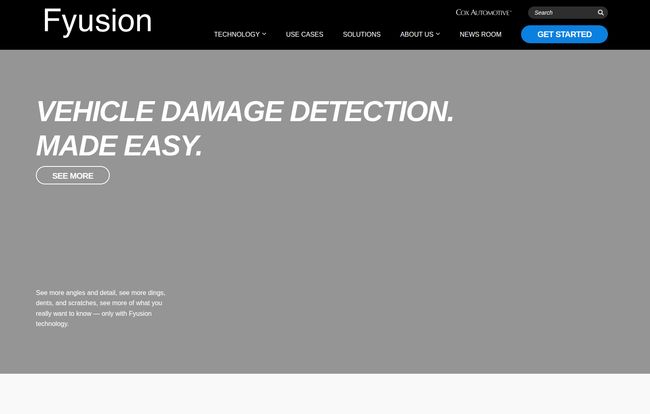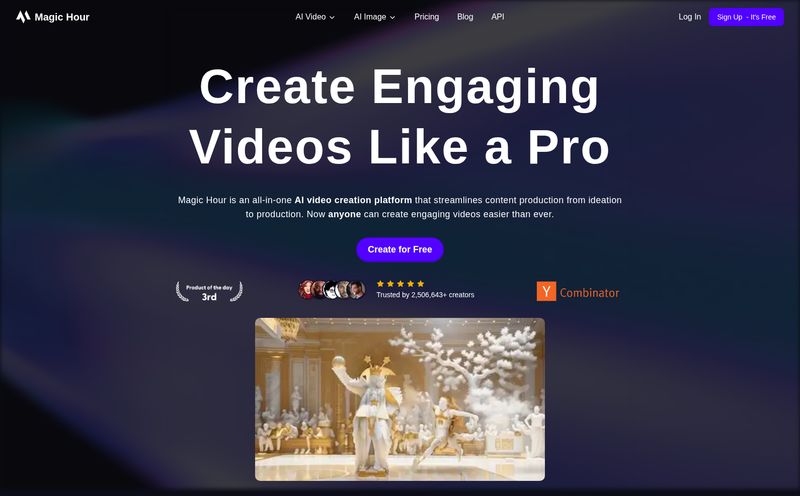For years, the vehicle condition report has been the bane of my existence. As someone who lives and breathes the automotive market, from wholesale auctions to retail lots, I’ve seen it all. Reports that are more art than science, descriptions so vague they could be about a car or a toaster, and photos that conveniently miss that one massive scratch on the bumper. It’s a system built on subjectivity, and frankly, it's a mess.
We’ve all been there, squinting at a grainy photo, trying to decide if that's a reflection or a four-inch-long key mark. It’s a process ripe for… let's call it 'interpretation'. So when a company comes along claiming they can make vehicle damage detection easy and objective, my ears perk up. The company is Fyusion, and their AI-powered platform isn't just another photo app. It’s a fundamental shift in how we look at, and understand, the state of a car.
So, What is Fyusion, Really?
At its core, Fyusion is an artificial intelligence platform designed for the automotive industry. But that's a bit corporate-speak, isn't it? Think of it this way: Fyusion does two things incredibly well, which their own website boils down to Imaging + Understanding. It’s not just about taking pictures of a car; it’s about creating a comprehensive, interactive 3D model and then letting a highly trained AI analyze every inch of it for damage.
It's the difference between a flat map and a live, 3D GPS. One gives you a static, outdated picture. The other gives you a dynamic, data-rich view of reality. This isn’t just about making things look cool (though it does), it’s about creating a single, undisputed source of truth for a vehicle's condition.

Visit Fyusion
The Magic Behind the Curtain: Key Features
Fyusion isn’t just one thing; it's a suite of tools working together. After spending some time with it, a few things really stand out.
Not Just Pictures, It's a 3D Experience
The first thing that grabs you is the 3D vehicle imaging. Using a standard smartphone or a fixed tunnel setup, the platform stitches together images to create a fully interactive, 360-degree view of the vehicle. You can spin it around, zoom in, and inspect it from any angle, almost like you're holding a perfect digital miniature in your hands. For online auctions or remote buyers, this is a total game-changer. No more guessing what the other side of the car looks like.
The AI Detective: Automated Damage Detection
This is the real secret sauce. Once the 3D image is created, Fyusion's AI gets to work. It’s been trained on millions of vehicle images to identify scratches, dents, scuffs, and other cosmetic damage with startling accuracy. It overlays these findings directly onto the 3D model, highlighting exactly what the issue is and where it’s located. This moves the inspection from a subjective human opinion—
Looks like a small dent on the rear quarter panel
—to an objective, data-driven fact. The AI isn't having a bad day, it didn't miss its morning coffee, and it doesn't play favorites. It just reports what it sees.
Condition Reports That Don’t Suck
The result of all this tech is a clean, comprehensive, and easy-to-read condition report. It combines the interactive 3D model with a list of detected damages, creating a document that's hard to argue with. For dealerships, this means fewer disputes during trade-in appraisals. For auctions, it means higher buyer confidence. And for collision centers, it offers a clear baseline for repair estimates. It builds trust, and in this industry, trust is money.
Who is This Actually For?
This isn't some niche tool for tech nerds. Fyusion has practical applications across the entire automotive ecosystem. I was especially impressed to see their deep integration with Manheim, the 800-pound gorilla of auto auctions. When a giant like Manheim, which is part of Cox Automotive, not only uses your tech but deploys it in massive fixed imaging tunnels, you know it's serious business. Cox Automotive actually acquired Fyusion back in 2021, which tells you everything you need to know about how critical they believe this technology is.
The main beneficiaries I see are:
- Wholesale Auctions: Like the Manheim example, it allows for consistent, high-volume inspections that build buyer trust and speed up sales cycles.
- Dealerships: For both trade-in appraisals and selling used inventory online. Imagine showing a potential online buyer an interactive 3D model with all minor flaws clearly noted. That's transparency that sells cars.
- Fleet & Mobility Companies: Think rental car returns or fleet management. Quickly and accurately assessing a vehicle's condition upon return can save thousands in missed damage claims.
- Collision and Repair: Creating an accurate, AI-verified record of damage before any work begins can streamline the insurance claim process and prevent customer disputes.
The Good, The Bad, and The AI
No tool is perfect, and as a professional, it's my job to see both sides. Let’s get real about the pros and potential hurdles.
Why I'm Genuinely Impressed
The upside is pretty clear. You get a massive boost in accuracy and consistency. You're taking the most variable part of the process—the human inspector—and giving them a tool that creates a standardized output every single time. The transparency it creates is probably the biggest selling point. It fosters trust between buyer and seller, which can lead to faster transactions and better prices. The whole process is just more efficient, cutting down on time spent arguing over he-said, she-said condition disputes.
Let's Be Real: Potential Hurdles
Now, for the reality check. Implementing a system like this isn't always plug-and-play. There could be a need for specific hardware or software integration, especially if you're going for a full imaging tunnel. Second, the AI's accuracy, while impressive, is still dependent on the quality of the images it's fed. Poor lighting, a dirty car, or a shaky hand during capture could affect the results. It's a classic 'garbage in, garbage out' scenario, though their guided capture feature aims to minimize this. And then there's the cost. This is enterprise-grade technology, and it's not going to be free. But I'll get to that in a second.
The Million-Dollar Question: What's the Price Tag?
If you're looking for a simple pricing page with neat little tiers, you won't find one for Fyusion. And that's typical for a B2B solution of this scale. The cost is likely based on a number of factors: the volume of vehicles you're scanning, the specific solutions you need (wholesale, retail, collision), and the level of integration required.
My advice? Don't let the lack of a public price tag scare you off. Think of it not as a cost, but as an investment. You have to calculate the ROI based on time saved, increased sale prices from higher trust, and fewer costly disputes. You'll need to contact their sales team for a custom quote, which makes sense for a tailored solution.
My Final Take: Is Fyusion Worth the Hype?
After looking at what Fyusion offers and seeing its real-world adoption by industry leaders, I have to say I'm optimistic. This feels like one of those pivotal shifts. For decades, we've relied on an analog system of trust and guesswork for one of the most critical parts of the car business. Fyusion replaces that with objective data.
Some might argue that it removes the 'human touch', but I disagree. I think it removes human error. It frees up your skilled appraisers and inspectors to focus on the things an AI can't assess—mechanical issues, weird smells, the overall feel of a car—while the AI handles the cosmetic stuff flawlessly. It’s not about replacing people, it’s about giving them better tools. And in an industry that's getting more digital by the day, better data is the ultimate tool.
Frequently Asked Questions
What exactly is Fyusion?
Fyusion is an AI technology company that provides 3D imaging and automated damage detection solutions for the automotive industry. It creates interactive 360-degree models of vehicles and uses artificial intelligence to identify and report cosmetic damage like scratches and dents.
How does Fyusion's damage detection work?
It uses a sophisticated AI model trained on a massive dataset of vehicle images. After a 3D image of a car is created, the AI analyzes its surfaces to identify deviations from a perfect finish, automatically flagging and categorizing different types of damage.
Is Fyusion suitable for small independent dealerships?
While they have large enterprise clients like Manheim, their solutions, particularly the smartphone-based image capture, can be scaled to fit different size operations. The best way to know for sure is to contact them directly to discuss the specific needs of a smaller dealership.
Do I need special cameras to use Fyusion?
Not necessarily. One of Fyusion's key features is its ability to work with images captured from standard smartphones, using a guided process to ensure quality. For higher volume operations, they also offer fixed-rig or drive-through imaging tunnel solutions for maximum efficiency.
How does Fyusion increase transparency in car sales?
By creating a single, objective, and verifiable record of a vehicle's condition. The interactive 3D model and AI-generated damage report leave little room for debate or misinterpretation. A buyer can see the exact condition for themselves, which builds trust and confidence in the transaction.
Who owns Fyusion?
Fyusion was acquired by Cox Automotive in 2021. Cox Automotive is a massive player in the industry, owning major brands like Manheim, Kelley Blue Book, and Autotrader. This acquisition shows a deep commitment to integrating Fyusion's technology across the automotive landscape.
Conclusion
The shift from subjective, paper-based conditon reports to objective, AI-driven digital analysis is inevitable. It's not a matter of if, but when. Platforms like Fyusion are leading that charge. By providing tools that enhance accuracy, build trust, and create massive efficiencies, they're not just offering a neat piece of tech; they're offering a smarter way to do business. And in this competitive market, smarter is always better.



